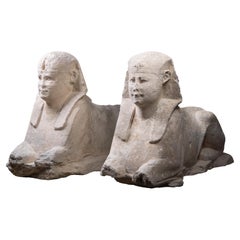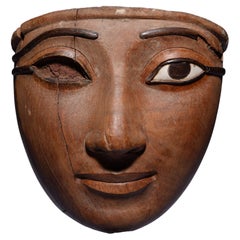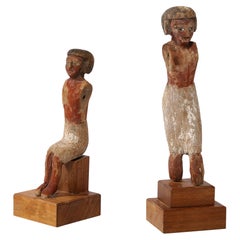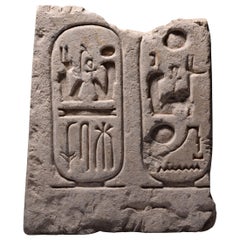Egyptian Mounted Objects
1
to
1
1
1
1
1
354
286
93
55
43
42
42
36
25
22
20
10
9
9
8
7
4
2
1
Height
to
Width
to
1
1
1
1
Style: Egyptian
Ancient Egyptian Mask, 900-600 BCE
Located in Doylestown, PA
An ancient burial mask that was created to adorn a sarcophagus, 26th Dynasty, Minia, Mid-Upper Nile, circa 900-600BCE, from the collection of Joanna Barnes and Jack Warner, (Warner B...
Category
15th Century and Earlier Egyptian Antique Egyptian Mounted Objects
Materials
Wood
Related Items
Ancient Egyptian Monumental Temple Sphinxes
Located in London, GB
A pair of monumental limestone sphinxes of Pharaoh Nectanebo I, from the processional avenue of the Serapeum of Memphis, 30th Dynasty, circa 379 - 360 BC.
The sphinxes of the Serapeum have captivated travellers since Roman times. However, despite their significance, they are conspicuously absent from the collections of most major museums. Indeed, their existence in private hands is so improbable, and their imitations so numerous, that the present sphinxes were assumed to be modern copies throughout their recent ownership history. Finally recognised and conserved after an extraordinary chance discovery at a garden furniture sale...
Category
15th Century and Earlier Egyptian Antique Egyptian Mounted Objects
Materials
Limestone
Exceptional Egyptian Sarcophagus Mask
Located in London, GB
Exceptionally Fine Wooden Sarcophagus Mask
Third Intermediate Period, 21st Dynasty, circa 1069-945 BC.
Acacia wood, rosewood, hippopotamus ivory
Masterfully carved from a single piece of fine-grained hardwood, the present mask is characteristic of the most exquisite funerary art made during the 21st Dynasty, and was probably commissioned for a particularly high-ranking individual.
The oval face displays a gently smiling mouth with full, outlined lips, furrows at the corners and a bow-shaped philtrum. The straight nose with rounded nostrils, the cheeks full and fleshy and the large, almond shaped eyes with heavy lids and tapering cosmetic lines, set below long, sweeping eyebrows.
Social collapse across the Mediterranean in the Late Bronze Age meant that the 21st Dynasty in Egypt was a period of great turmoil. Trade routes were disrupted, governments collapsed, and mass migration occurred. Economic scarcity meant that traditional funerary practices in Egypt were also affected, with a lack of material and financial resources leading to the reuse of preexisting material. As a result, during the 21st Dynasty, 19th and 20th Dynasty coffins changed ownership rapidly and were heavily recycled for new purposes. Tombs were also unmarked allowing them to be shared
by many people. These new practices brought forth a shift in the understanding of funerary paraphernalia. No longer important objects owned forever by the deceased, they were now simply seen as short-term transformative devices, whose symbolic and ritualistic meaning could be appropriated for others. However, paradoxically, the art of coffin-making also reached new heights during this period, and many of the richly dec- orated “yellow” coffins, characteristic of the 21st Dynasty, are remarkable works of art in their own right. Indeed, knowing that coffins were being reused throughout Egypt, the Egyptian élite set themself apart by commissioning lavish sarcophagi decorated with the images and texts meant to help guide them to the afterlife, and which would otherwise have adorned the tomb walls. As coffins were the chief funerary element which now identified the dead and allowed them a physical presence in the world of the living, their quality and appearance were of the utmost importance.
The traditional coffin ensemble was made of three parts: a wooden mummy cover, which laid directly atop the mummy, an inner coffin, and an outer coffin, both made of a lid and case. Additional decorative elements, such as masks, were carved out separately and later glued or pegged to the lids. After the completion of the painted decoration, the sarcophagus was covered in a varnish to give it its yellow colour. Gilding was sometimes used for the coffins of the high priests’ families, notably on parts representing naked skin, such as the face mask. However, some of the élite tactically avoided gilding altogether as to ensure that their coffin would not be looted.
When manufacturing the inner and outer coffins, particular attention was paid to the woodwork. Displaying the skill of the carpenter, this type of funerary art has largely remained unparalleled throughout Egyptian history. The principal wood used to craft the present mask is Acacia nilotica. The evergreen Egyptian acacia was considered sacred and said to be the tree of life, the birthplace of the god Horus, as well as symbolic of Osiris, the god of the dead and resurrection. The modelling of the face in the wood is superb, but the inlays also help mark this mask out as exceptional. Inlaid eyes and eyebrows were extremely rare and reserved to the finest and most expensive coffins. Traditionally, eyes were made of calcite, obsidian, or quartz, and eyebrows of coloured glass paste or bronze. Here, the pupils, eyebrows, and cosmetic lines are inlaid with Dalbergia melanoxylon, a rare type of wood which belongs to the rosewood genus.
In antiquity, however, it was known as Ebony of the Pharaohs, from the Egyptian word “hbny”, meaning dark timber, because of its black, lustrous appearance. An extremely dense and hard wood requiring significant skill to work with, ebony was a luxury material highly coveted by the pharaohs themselves, to make furniture, decorative and funerary objects. The wood was imported with great effort from the southern Land of Punt, most likely modern Sudan, Ethiopia, Djibouti, and Eritrea, alongside other luxury goods such as gold and ivory.
A magnificent ebony throne, recovered in the tomb of King Tutankhamun, illustrates the incredible aesthetic potential of this material and why it was so highly valued by Egyptian royalty. Only élite members of Egyptian society could have afford- ed Ebony of the Pharaoh inlays for their funerary mask.
The sclerae on the present piece were once both inlaid with hippopotamus ivory. Whiter than elephant ivory, this type of ivory is also denser, and more difficult to carve. The use of this luxury material, reputed for its gleaming appearance, enhances the lifelikeness of the eyes. For the Egyptians, hippopotamus ivory was imbued with magic powers. The hippopotamus was indeed both feared and venerated due to its aggressive behaviour. Whilst the male hippopotamus was associated with danger and chaos, the female was benevolent and invoked for protection, especially of the house and
of mothers and their children, through the hippopotamus goddess Tawaret. Thus, not only was hippopotamus ivory used as an inlay and to make practical objects, such as combs and clappers, but it was also used to make talismans like apotropaic wands or knives.
Made during a time of scarcity where few could afford made-to-order coffins, the present mask could have only belonged to one of the highest-ranking individuals in society. Undoubtedly one of the finest Egyptian coffin...
Category
15th Century and Earlier Egyptian Antique Egyptian Mounted Objects
Materials
Fruitwood, Hardwood
Egyptian Head of a Man
Located in London, GB
Egyptian head of a man, carved granite. 18th Dynasty, circa 1550-1292 B.C.
Carved in beautiful dark granite, this head depicts an elite individual, perha...
Category
15th Century and Earlier Egyptian Antique Egyptian Mounted Objects
Materials
Granite
Ancient Roman Theathre Mask Myra No:1 Sculpture
By LAGU
Located in İSTANBUL, TR
It was found in the ancient city of Myra in Antalya, Turkey. It was used as a mask in theaters during the Roman period.
The city of Myra, one of the six most important cities that w...
Category
2010s Turkish Egyptian Mounted Objects
Materials
Statuary Marble
Ancient Roman Theathre Mask Myra No:2 Statue
By LAGU
Located in İSTANBUL, TR
It was found in the ancient city of Myra in Antalya, Turkey. It was used as a mask in theaters during the Roman period.
The city of Myra, one of the six most important cities that w...
Category
2010s Turkish Egyptian Mounted Objects
Materials
Statuary Marble
Grand Tour Ancient Egyptian Style Carved Soapstone Figure of Horus
Located in Stamford, CT
Grand Tour carving of Horus, ancient Egyptian god in the form of a falcon. Quite possibly much earlier in date, that is beyond my expertise. From a collection that did have ancient p...
Category
Late 19th Century Egyptian Antique Egyptian Mounted Objects
Materials
Soapstone
Maya Redware Turtle Bowl, c. 600-900 AD
Located in Chicago, IL
Exhibiting a rich patina, this petite redware bowl is attributed to Maya culture and shows many telltale signs of Pre-Columbian pottery. Speckled with imp...
Category
15th Century and Earlier Central American Antique Egyptian Mounted Objects
Materials
Ceramic
Ancient Olmec Greenstone Portrait Mask with Pre-1970 Provenance
Located in Culver City, CA
A large and powerful portrait mask depicting an important Olmec ruler, with a broad face, furrowed brow, rectangular ear flanges, full lips, and a large nose, carved from a variegate...
Category
15th Century and Earlier Mexican Antique Egyptian Mounted Objects
Materials
Stone
Chinese or Korean Antique Wooden Large Mask/1800s/Festival Mask/Dance Mask
Located in Sammu-shi, Chiba
This is a very old wooden mask made in China or Korea, probably around the 1800s.
Many masks are also made in Japan, and their roots are said to come from China.
Famous items include...
Category
19th Century Chinese Antique Egyptian Mounted Objects
Materials
Wood
H 17.52 in W 16.54 in D 6.7 in
Bronze Egyptian Cat Goddess Bastet
Located in Paddock Wood Tonbridge, GB
BRONZE EGYPTIAN CAT GODDESS
A rare and stylised gold patinated solid bronze cast cat god ‘Bastet’ with hollow eyes produced in the Art Deco period, havin...
Category
1930s French Vintage Egyptian Mounted Objects
Materials
Bronze
19th Century French Empire Bronze & Ormolu Egyptian Style Clock Clock
Located in London, GB
A French Empire bronze and ormolu clock in the Egyptian style with 8 day silk-suspension striking movement by Hemon a Paris, also marked “Ledure Bronzier”, enclosed in bronze obelisk...
Category
19th Century French Antique Egyptian Mounted Objects
Materials
Bronze
Egyptian White Head Plaster Sculpture
Located in Pasadena, CA
Unsigned, this heavy white head plaster sculpture conveys a majestic impression thanks to the skillful combination of curved and sharp lines.
The back of t...
Category
Late 20th Century Unknown Egyptian Mounted Objects
Materials
Plaster
Previously Available Items
Ancient Egyptian Tomb Oarsman in Painted Wood
Located in New York, NY
Oarsman carved of wood, originally primed with stucco and painted. This figure formed part of the crew who, some seated, some standing, manned the so-called "sun barges", models of t...
Category
15th Century and Earlier Egyptian Antique Egyptian Mounted Objects
Materials
Wood
Egyptian Limestone Cartouche of Ramesses the Great, 1279 BC
Located in London, GB
Egyptian limestone relief fragment with cartouches for Ramesses the Great, New Kingdom, 19th dynasty, circa 1279-1213 BC.
The cartouches carved in ...
Category
15th Century and Earlier Egyptian Antique Egyptian Mounted Objects
Materials
Limestone
Free Shipping
H 11.75 in W 9.75 in D 3.75 in
Ancient Egyptian New Kingdom Shabti for Iuferbaku
Located in London, GB
Finely carved in wood with remnants of blue and gold gesso, this beautiful mummiform shabti was deposited in the tomb of Iuferbaku to act as his servant in the afterlife and perform ...
Category
15th Century and Earlier Egyptian Antique Egyptian Mounted Objects
Materials
Wood
Vintage Camel Saddle
Located in Brooklyn, NY
Unusual wood saddle for camel riding. Could make a unique table base. (Please confirm item location - NY or NJ - with dealer).
Category
20th Century Egyptian Mounted Objects
Materials
Wood
Egyptian Poly-Chrome Wood Mask 100-200 BC Garniture Sarcophagus Face Mask statue
Located in West Hollywood, CA
------------------- 14% will expire Monday Sep 27th-------
Egyptian poly-chrome wood mask 100-200 BC garniture
Historic. An ancient Egyptian wooden face mask, once part of a large anthropoid sarcophagus.
Sensitively carved from a large piece of cedar wood, with large almond shaped eyes,Once covered in thick paint, remnants of which survive, now dark in color. Beautifully weathered, revealing the grain of the wood beneath.
Provenance: Anthony Duquette an american artist specialized in designs for stage and film. Duquette was born in Los Angeles, California. He grew up between Los Angeles, where he wintered with his family, and Three Rivers, Michigan, where they lived the rest of the year. As a student, Duquette was awarded scholarships at both the Chouinard Art Institute in Los Angeles and the Yale School of the Theatre. After graduating from Chouinard, he began working in advertising, creating special environments for the latest seasonal fashions. He also began to free-lance for designers such as William Haines, James Pendleton and Adrian. In the early 1940s, Duquette's parents and siblings moved permanently to Los Angeles, where Duquette had been living since 1935. During this time Duquette was discovered by designer and socialite Elsie de Wolfe. Through the patronage of de Wolfe and her husband Sir Charles Mendl, Duquette established himself as one of the leading designers in Los Angeles. He worked increasingly for films, including many Metro Goldwyn Mayer productions under the auspices of producer Arthur Freed and director Vincente Minnelli.
Upon his return from Europe in 1947, Duquette continued his works for private clients and for the theatre and motion pictures. He presented his first exhibition at the Mitch Liesen Gallery in Los Angeles and shortly thereafter was asked to present his works at the Pavilion de Marsan of the Louvre Museum, Paris. Duquette was the first American artist to have a one-man show at the Louvre.[citation needed] Returning from a year in France, where he received design commissions from the Duke and Duchess of Windsor and the Alsatian industrialist Commandant Paul Louis Weiller, Duquette held a one-man showing of his works at the Los Angeles County Museum of Art.
There followed other one-man exhibitions of Duquette's works, including at the M. H. de Young Museum and Palace of the Legion of Honor in San Francisco, the California Museum of Science and Industry and Municipal Art Gallery in Los Angeles, the El Paso Museum of Art, the Santa Barbara Museum of Art, the Museum of the City of New York, as well as one-man exhibitions in Dallas, Chicago, Rio de Janeiro and Phoenix, Arizona.
In 1956, with his wife Elizabeth (known as Beegle), he opened a salon in the converted silent film studios of actress Norma Talmadge, where they entertained friends such as Arthur Rubenstein, Aldous Huxley, Jascha Heifitz and Greta Garbo.
1960–1970s
During the 1960s and '70s, the Duquettes continued to travel extensively, working in Austria, Ireland and France as well as New York, Dallas, San Francisco, South America and Asia. Duquette created interiors for Doris Duke, Norton Simon, and J. Paul Getty, a castle in Ireland for Elizabeth Arden and a penthouse in the Hawaiian Islands. He also designed interiors for commercial and public spaces like the Hilton Hawaiian Village, Sheraton Universal Hotel, and sculptures and tapestries for the Ritz Carlton Hotel in Chicago as well as the Los Angeles Music Center and the University of California at Los Angeles. Designs for film and theatre include Yolanda and the Thief, Lovely to Look At, Kismet, and Ziegfeld Follies for MGM, as well as Jest of Cards, Beauty and the Beast, and Danses Concertantes for the San Francisco Ballet. Operas for which Duquette designed both costumes and settings include Der Rosenkavelier, The Magic Flute, and Salome. His designs for the original Broadway production of Camelot won Duquette the Tony Award for Best Costume Design.
His monumental work of environmental art Our Lady Queen of the Angels was created as a gift to the people of Los Angeles in honor of that city's lyrical name[2] and in celebration of the bicentennial. This hugely successful multi-sensorial exhibit was seen by hundreds of thousands of visitors over a three-year period at the California State Museum of Science and Industry at Exposition Park. As part of the unique experience of "ethnic angels," Duquette included a poetic narration by Ray Bradbury, spoken by Charlton Heston. Duquette embellished the celebratory experience with original music by Garth Hudson (reissued in 2005). The immense size of the building added to the effect, where from the 80 foot ceiling hung an 18-foot Madonna, dressed in an ornate and symbolic gown. She was surrounded by angels and alters and jeweled tapestries. All of this was enhanced by special lighting effects which changed the Madonna's facial color "to represent the four races."[2] Duquette researched angels and learned every major world religion (Catholic, Jewish, Moslem, Buddhist, Hindu believes in the same eight archangels.[3] "Duquette writes that his 'Angels' exhibit stresses over and over again 'the brotherhood of man, which is an implied theme of this 'celebration." He stated, "It is my hope that this celebrational environment, into which I have poured the aspirations of a lifetime, will transport the viewer to another dimension."[4]
In 1979, the Duquettes formed the Anthony and Elizabeth Duquette...
Category
15th Century and Earlier Egyptian Antique Egyptian Mounted Objects
Materials
Wood
H 11 in W 10 in D 3 in
Ancient Egyptian Stone Bust of Bes, 332 BC
Located in London, GB
Quartzite bust of Bes, guardian of the household, patron of childbirth and god of war. Dating to Egypt's Ptolemaic Period, circa 332 - 30 BC.
The rounded head with large, oval ey...
Category
15th Century and Earlier Egyptian Antique Egyptian Mounted Objects
Materials
Stone
Paleolithic Homo Erectus Egyptian Flint Tool from Thebes, 300, 000 BC
Located in London, GB
An Egyptian Homo erectus flint scraper tool from Thebes, dating to the Middle Palaeolithic, circa 300,000 years ago.
Skilfully worked from a weighty block of flint and covered with ...
Category
15th Century and Earlier Egyptian Antique Egyptian Mounted Objects
Materials
Other
Free Shipping
H 6.5 in W 4 in D 5 in
Paleolithic Homo Erectus Flint Hand Axe, 800, 000 BC
Located in London, GB
A large Acheulian flint hand axe, likely produced by Homo erectus. Found in northern France, dating to around 800,000 - 100,000 years ago.
Worked from a su...
Category
15th Century and Earlier Egyptian Antique Egyptian Mounted Objects
Ancient Egyptian Bronze Sacred Ibis Bird, 664 BC
Located in London, GB
An Egyptian bronze figure of an Ibis, dating to the Late Period, circa 664-332 BC.
Modelled with left leg forward, the creature's distinctiv...
Category
15th Century and Earlier Egyptian Antique Egyptian Mounted Objects
Materials
Bronze
Ancient Egyptian Faience Daisy Flower Rosettes, 1550 BC
Located in London, GB
Four Egyptian faience rosettes, dating to the New Kingdom, Reign of Ramesses, 1550-1295 BC.
These remarkable inlays are often called rosettes, though they probably depict daisies or...
Category
15th Century and Earlier Egyptian Antique Egyptian Mounted Objects
Materials
Faience
Ancient Egyptian Wooden Shabti, 1295 BC
Located in London, GB
A well provenanced and striking ancient Egyptian wooden shabti, dating to the New Kingdom, Ramesside Period, 19th-20th Dynasty, circa 1295-1070 BC.
The figure is depicted mummifor...
Category
15th Century and Earlier Antique Egyptian Mounted Objects
Ancient Egyptian Painted Sarcophagus Panel, 100 BC
Located in London, GB
A vibrant ancient Egyptian painted wood panel. Depicting a well known scene from the Book of the Dead. Dating to the Ptolemaic period, circa 100 BC.
...
Category
15th Century and Earlier Antique Egyptian Mounted Objects
Egyptian mounted objects for sale on 1stDibs.
Find a broad range of unique Egyptian mounted objects for sale on 1stDibs. Many of these items were first offered in the 18th Century and Earlier, but contemporary artisans have continued to produce works inspired by this style. If you’re looking to add vintage mounted objects created in this style to your space, the works available on 1stDibs include decorative objects and other home furnishings, frequently crafted with wood and other materials. If you’re shopping for used Egyptian mounted objects made in a specific country, there are Africa, Egypt, and North Africa pieces for sale on 1stDibs. It’s true that these talented designers have at times inspired knockoffs, but our experienced specialists have partnered with only top vetted sellers to offer authentic pieces that come with a buyer protection guarantee. Prices for mounted objects differ depending upon multiple factors, including designer, materials, construction methods, condition and provenance. On 1stDibs, the price for these items starts at $2,250 and tops out at $2,250 while the average work can sell for $2,250.
Recently Viewed
View AllMore Ways To Browse
Basalt Log On Steel Base
Tiger Iron Slab
Topoke Sword
A Pasino
Rene Andre Coulon
Aluminum Carousel Horse
Hao Zhenhan
Acrylic Lucite Chinese Art
French Deconstructed Clawed Lobster Sculpture In Glass Case
Antique Vintage Tractors
Antique Vintage Tractor
Peridot Antique Furniture
Harry Paley
Agate Goblets
Blue Coral Madrepora
Cloche Intaglio
Odd Fellows Mask
English 19th Century Glass Cloche With New




